Nuclear Imaging Market Size
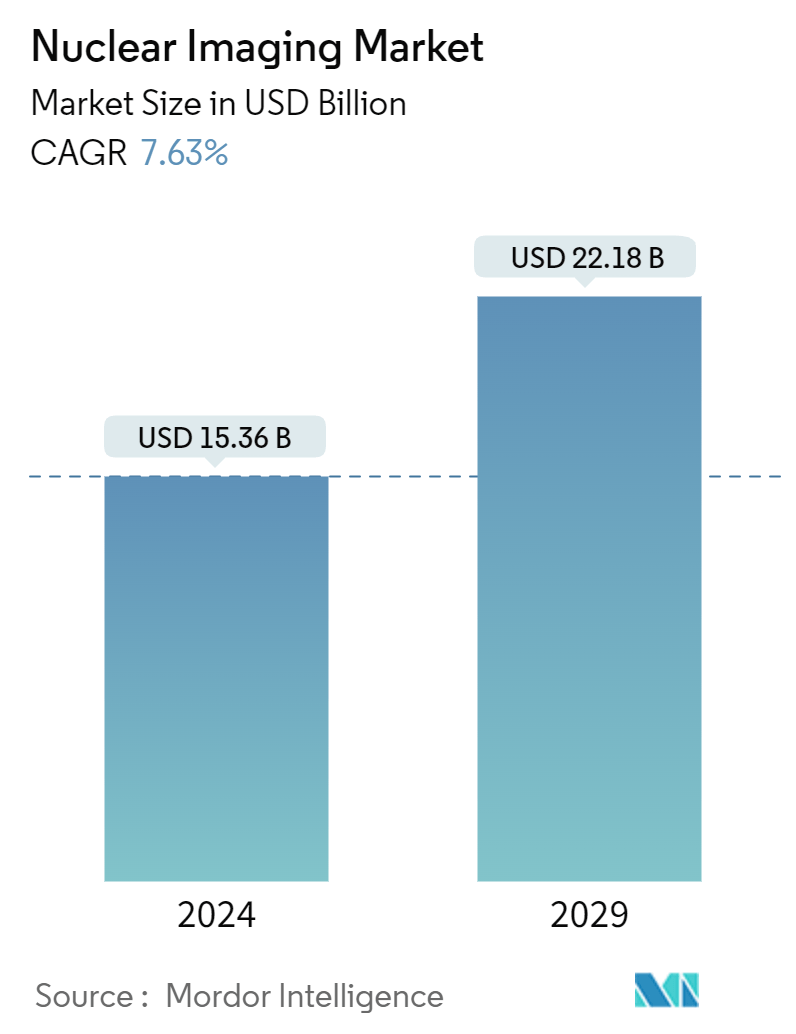
| Study Period | 2019 - 2029 |
| Market Size (2024) | USD 15.36 Billion |
| Market Size (2029) | USD 22.18 Billion |
| CAGR (2024 - 2029) | 7.63 % |
| Fastest Growing Market | Asia-Pacific |
| Largest Market | North America |
| Market Concentration | Medium |
Major Players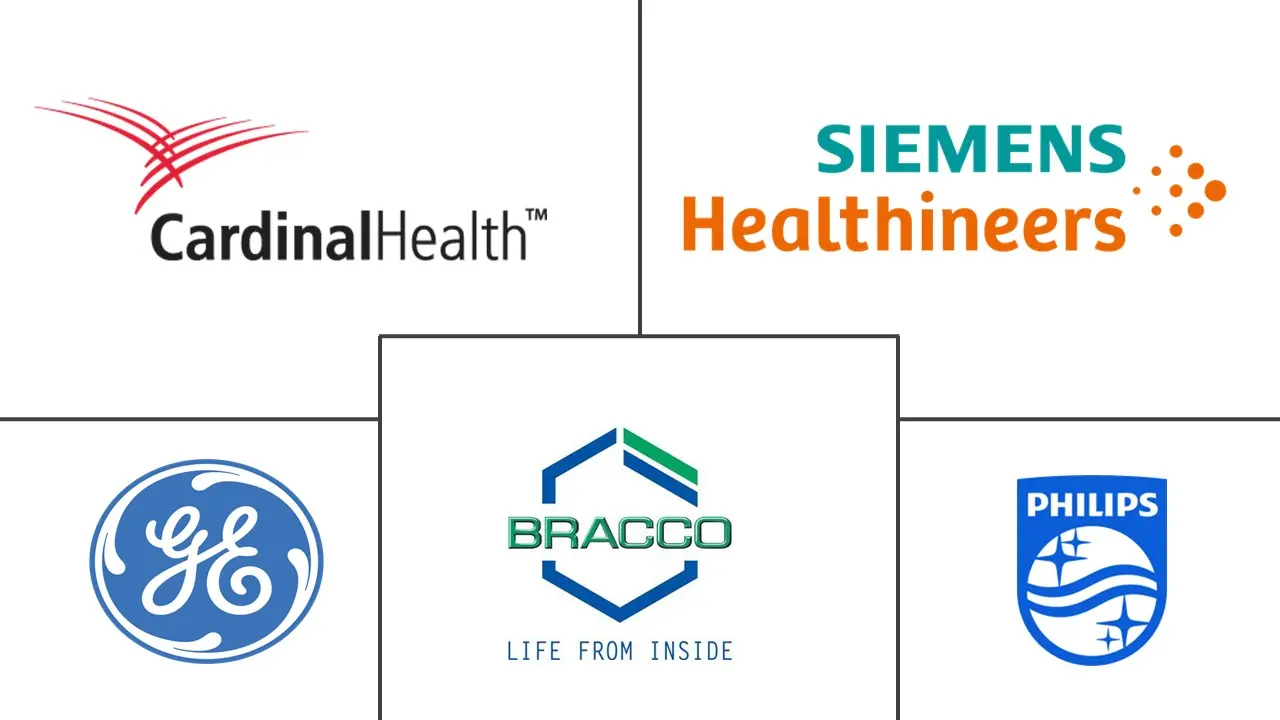
*Disclaimer: Major Players sorted in no particular order |
Nuclear Imaging Market Analysis
The Nuclear Imaging Market size is estimated at USD 15.36 billion in 2024, and is expected to reach USD 22.18 billion by 2029, growing at a CAGR of 7.63% during the forecast period (2024-2029).
The Nuclear Imaging Market was moderately impacted due to the pandemic. The operation of reactors has been largely classified as an essential service, given its criticality. Therefore, Nuclear Reactors were not shut down during the lockdown. For instance, under Section 71 of the Labour Act 66 of 1995 in South Africa, its SAFARI-1 Reactor remained operational during the lockdown enforced in the country post-March 2020.
However, according to an article published in Seminar in Nuclear Medicine in June 2021, the number of Nuclear Studies, Nuclear Cardiac Imaging, and Oncology Positron Emission Tomography/Computed Tomography decreased in March and April 2020 due to the rise of COVID-19 cases and deaths as reported by the Centers for Disease Control and Prevention (CDC). The study further stated that procedures increased from June 2020 to February 2021 as COVID-19 cases declined. Thus, COVID-19 has slightly impacted the Nuclear Imaging Market with delays in clinical studies, postponement of various surgeries and imaging procedures, an increase in Teleradiology, and several staff-related limitations. However, since the lockdown restrictions were lifted, the industry has been recovering well.
Over the last two years, the market recovery has been led by the high prevalence of chronic diseases. Patients' hospital visits for imaging diagnosis increased as the restrictions were relaxed, and so the Medical Imaging Industry saw a major surge in diagnostics and treatment. This is expected to promote the market's growth in the next few years.
Certain factors that are propelling the growth of the market include technological advancements, increasing diagnostic applications in various diseases, such as cancer and cardiovascular diseases, government support, and a shift from standalone imaging to Hybrid Imaging Systems modalities. For instance, according to the Breast Cancer Factsheet Now 2021, around 55,000 women and 370 men in the United Kingdom are diagnosed with breast cancer every year. Breast cancer has claimed the lives of an estimated 600,000 people in the United Kingdom. This figure is expected to climb to 1.2 million by 2030. Moreover, the growing prevalence of heart diseases is expected to propel the growth of the market. As stated by the American Heart Association 2021 Journal, it is estimated that by 2035, more than 130 million adults in the United States will have some type of heart disease. Thus, the growing prevalence of chronic diseases such as cancer and cardiac diseases is expected to increase demand for early and effective diagnosis, thereby boosting the growth of the Nuclear Imaging Market over the forecast period.
Technological advancements in the Medical Nuclear Imaging System Market have always been challenging to practitioners in terms of how best to optimize them in patient care. Over the past few years, scientists, researchers, and technologists have been able to bring Hybrid Imaging Systems into clinical practice, in which two or even more standalone diagnostic imaging modalities are combined. Some of those multimodality imaging systems include PET/CT, SPECT/CT, PET/MRI, and PET/SPECT/CT. For instance, in October 2022, Spectrum Dynamics announced its newest development in digital Nuclear Medicine Imaging capability to image high-energy isotopes using solid-state detector technology in a 3600-CZT-based, wide-bore SPECT/CT configuration. This functionality is available in the new VERITON-CT 400 Series Digital SPECT/CT scanners, enabling total body, brain, heart, and other imaging applications. With such advances in Nuclear Imaging, the market studied is expected to grow significantly over the forecast period.
The key players are working on many strategic initiatives such as mergers, acquisitions, collaborations, partnerships, and product launches. For instance, in January 2021, Koninklijke Philips NV and Rennes University Hospital signed a five-year innovation and technology partnership to support PET diagnostics, interventional imaging, patient monitoring, and management, among other things. Additionally, in March 2021, GE Healthcare launched StarGuide in the United Kingdom, a next-generation SPECT/CT system that uses the latest digital technologies to help clinicians improve patient outcomes in bone procedures, cardiology, neurology, oncology, and other specialties.
According to the factors mentioned above, such as the growing prevalence of chronic diseases and technological advances in Nuclear Medicine Imaging, the market studied is anticipated to witness growth over the forecast period. However, regulatory issues and a lack of reimbursement may restrain the market's growth.
Nuclear Imaging Market Trends
Oncology is Expected to Hold the Significant Market Share in PET Applications over the Forecast Period
Radiopharmaceuticals have been heavily used in the imaging of cancer in recent times. According to the REDECAN Report published in November 2022, breast cancer is the most frequent cancer and the primary cause of cancer-related death in women in Spain, with an estimated 34,750 women diagnosed with the disease in 2022. Additionally, as per the same source, there were estimated to be 30,948 new cases of lung cancer diagnosed in Spain in 2022. In 2022, 22,316 men and 8,632 women were estimated to be diagnosed with lung cancer. Thus, the growing prevalence of cancer and the need for early diagnostics using Nuclear Diagnostic Imaging are expected to increase, supporting the segment's expansion over the forecast period.
In oncology, PET (Positron Emission Tomography) uses FDG (18 Fluorine-2-Fluoro-2-Deoxy-D-Glucose) as the radiopharmaceutical, as it demonstrates the increased metabolism by malignant cells when compared to that of normal cells. This technique can be used for the imaging of lung cancer, lymphoma, head and neck tumors, breast cancer, esophageal cancer, colorectal cancer, and urinary tract tumors. Furthermore, increased research and development in the Nuclear Medicine Industry are anticipated to boost the market's growth. For instance, as per the press release published in 2022 by the Society of Nuclear Medicine and Molecular Imaging, according to new research presented at the Society of Nuclear Medicine and Molecular Imaging 2022 Annual Meeting, a newly developed small-molecular radiopharmaceutical pair has successfully visualized and treated melanoma in a preclinical study.
Furthermore, new product launches are expected to aid the growth of the segment during the forecast period. In March 2022, the United States Food and Drug Administration (FDA) approved Novartis' complementary diagnostic imaging agent, Locametz, which is significant for the PSMA PET Imaging Market. Locametz, after radiolabeling with Gallium-68, is used for the identification of prostate-specific membrane antigen (PSMA)-positive lesions. The FDA also approved Novartis's Pluvicto in March 2022 for the imaging of adult patients with a specific type of advanced cancer called prostate-specific membrane antigen-positive metastatic castration-resistant prostate cancer (PSMA-positive mCRPC) that will spread to other parts of the body. Additionally, in February 2022, Monrol signed an agreement with Curium Netherlands to license its good manufacturing practice (GMP)-grade medical radioisotope, no-carrier-added 177Lu, and cutting-edge production technology LuMagic. Hence, due to the factors mentioned above, such as the growing burden of cancer and product launches, the Nuclear Imaging Devices Market is expected to witness growth over the forecast period.
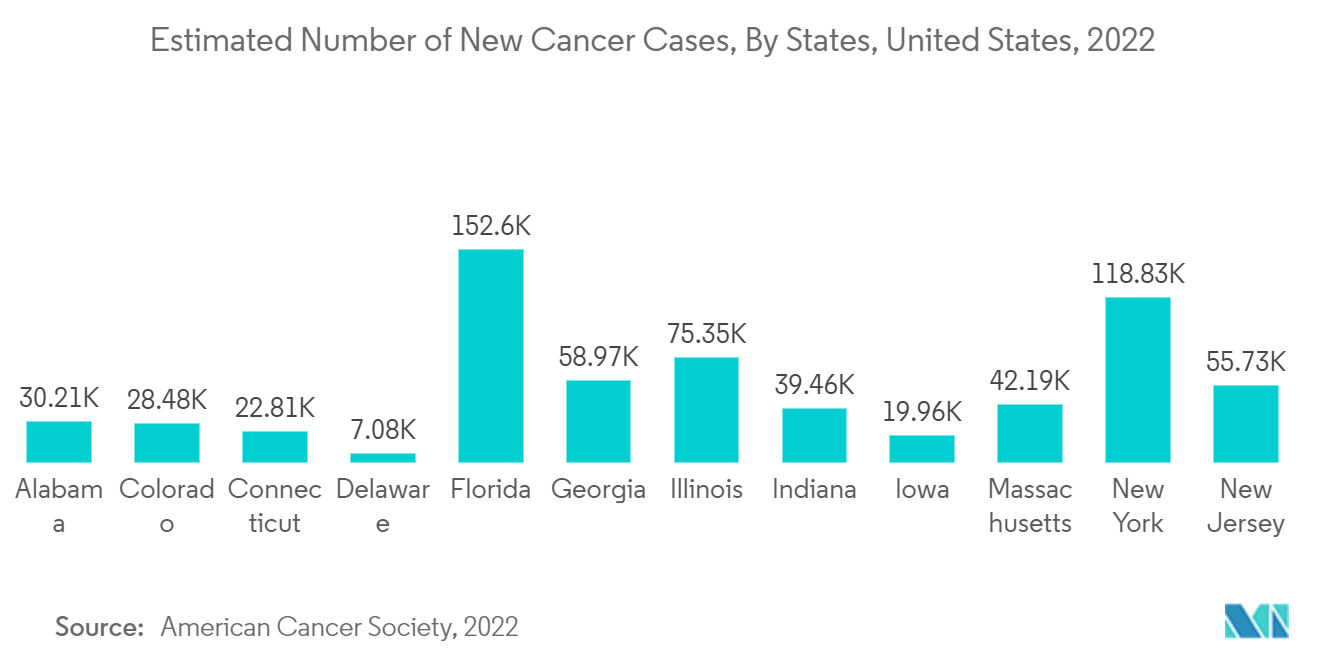
North America is Expected to Hold a Significant Share in the Market and Expected to do the Same in the Forecast Period
North America is projected to account for the largest share of the market due to advancements in technology, including growth in the Hybrid Imaging Systems Market, the introduction of new radiopharmaceuticals for diagnosis, and the development of the Molecular Imaging Market.
The robust growth of the healthcare sector in the United States, the increasing incidences of cancer, the growing geriatric population, and the increase in product launches account for the growth of the market. According to statistics published in November 2021 by the Government of Canada, an estimated 229,200 Canadians were diagnosed with cancer in 2021, and 84,600 died from it. Lung, breast, colorectal, and prostate cancers are expected to remain the most commonly diagnosed cancers, accounting for 46% of all diagnoses in 2021. According to the survey, breast cancer affects one out of every eight women at some point in their lives. As the number of incidences of cancer increases, the urge for early detection also rises, propelling demand for Nuclear Imaging over the forecast period. Similarly, the CDC reported in September 2021 that approximately 6.5 million people in the United States aged 40 and older had peripheral arterial disease in 2021. Thus, the high burden of cardiovascular diseases is expected to drive the demand for effective diagnoses such as Nuclear Imaging and fuel the growth of the market in the country over the forecast period.
The presence of competitors, collaborations, and research initiatives boost the market's growth. For instance, in 2021, the Canadian Nuclear Safety Commission (CNSC) amended Ontario Power Generation's (OPG) operating license for its Darlington Nuclear Power Station near Clarington, Ontario, allowing the company to produce the medical radioisotope Molybdenum-99 using Darlington's Unit 2 CANDU Reactor. A precursor to Technetium-99m, Molybdenum-99 (Mo-99) is used in more than 40 million procedures a year to detect cancer and diagnose various medical conditions. With the use of Technetium 99m in radiopharmaceuticals, the market is expected to grow at a tremendous rate in Canada.
The number of launches in the North American region by market players is expected to increase the demand for Nuclear Imaging. For instance, in October 2022, Spectrum Dynamics introduced its newest development, the capability to image high-energy isotopes using solid-state detector technology in a CZT-based, wide-bore SPECT/CT configuration. This functionality is available in the new VERITON-CT 400 Series Digital SPECT/CT scanners, enabling Whole Body Imaging applications. Thus, owing to the factors mentioned above, such as the growing prevalence of cancer and cardiac diseases coupled with product launches, North America is expected to register a significant growth rate for the market studied over the forecast period.
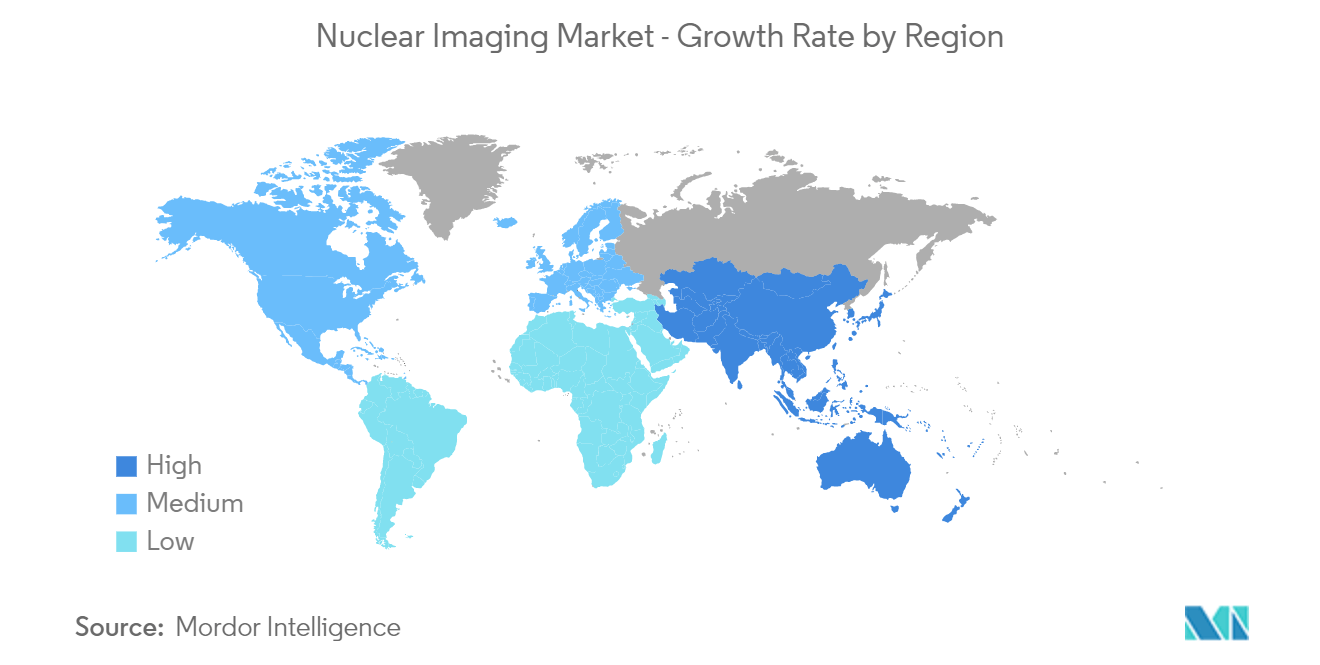
Nuclear Imaging Industry Overview
The global Nuclear Imaging Equipment Market is highly competitive and consists of several major players. In terms of market share, a few of the major players currently dominate the market. Companies like Bracco Imaging SpA, Curium, Cardinal Health Inc., Koninklijke Philips NV, General Electric Company (GE Healthcare), and Siemens Healthineers hold a substantial share of the market. Leading market players are opting for geographic expansion, strategic collaborations, and partnerships through mergers and acquisitions in emerging and economically favorable regions.
Nuclear Imaging Market Leaders
-
Bracco Imaging SpA
-
Cardinal Health Inc.
-
Koninklijke Philips NV
-
Siemens Healthineers
-
General Electric Company (GE Healthcare)
*Disclaimer: Major Players sorted in no particular order
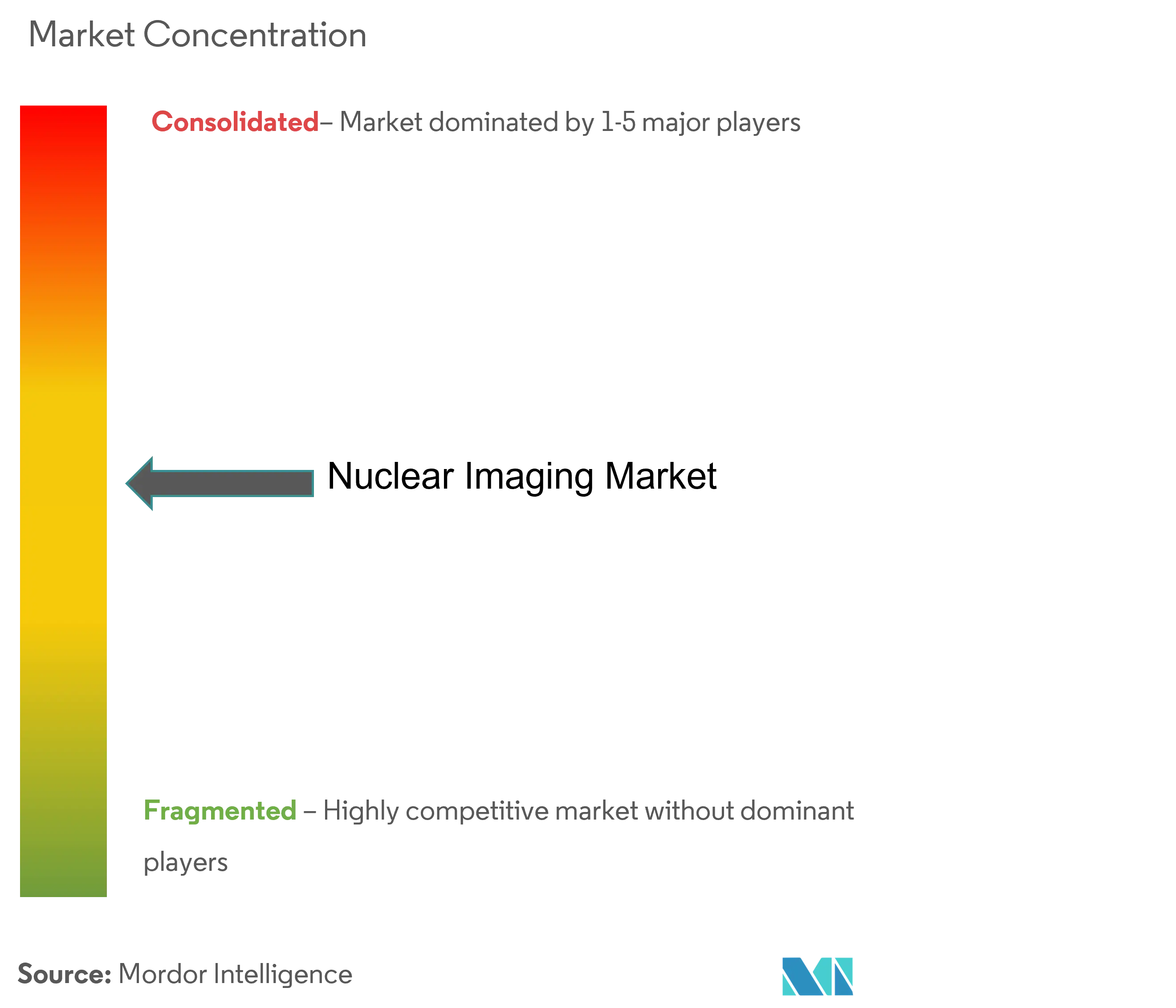
Nuclear Imaging Market News
- October 2022: United Imaging Healthcare announced the launch of total-body PET/CT, uEXPLORER, with a 194 cm axial PET field of view (FOV) that allows the complete body to be scanned in a one-bed position. The ultra-high-resolution digital PET/CT system provides total-body dynamic scanning, allowing ultra-low patient dose, and delivering ultra-high picture resolution, thereby revolutionizing whole-body PET/CT imaging.
- October 2022: GE Healthcare introduced the Omni Legend positron emission tomography/ computed tomography (PET/CT) platform at the 35th Annual Congress of the European Association of Nuclear Medicine (EANM) in Barcelona, Spain.
Nuclear Imaging Market Report - Table of Contents
1. INTRODUCTION
1.1 Study Assumptions and Market Definition
1.2 Scope of the Study
2. RESEARCH METHODOLOGY
3. EXECUTIVE SUMMARY
4. MARKET DYNAMICS
4.1 Market Overview
4.2 Market Drivers
4.2.1 Rise in Prevalence of Cancer and Cardiac Disorders
4.2.2 Increase in Technological Advancements
4.2.3 Growth in Applications of Nuclear Medicine and Imaging
4.3 Market Restraints
4.3.1 Regulatory Issues
4.3.2 Lack of Reimbursement
4.4 Industry Attractiveness - Porter's Five Forces Analysis
4.4.1 Threat of New Entrants
4.4.2 Bargaining Power of Buyers/Consumers
4.4.3 Bargaining Power of Suppliers
4.4.4 Threat of Substitute Products
4.4.5 Intensity of Competitive Rivalry
5. MARKET SEGMENTATION (Market Size by Value - USD Million)
5.1 By Product
5.1.1 Equipment
5.1.2 Radioisotope
5.1.2.1 SPECT Radioisotopes
5.1.2.1.1 Technetium-99m (TC-99m)
5.1.2.1.2 Thallium-201 (TI-201)
5.1.2.1.3 Gallium (Ga-67)
5.1.2.1.4 Iodine (I-123)
5.1.2.1.5 Other SPECT Radioisotopes
5.1.2.2 PET Radioisotopes
5.1.2.2.1 Fluorine-18 (F-18)
5.1.2.2.2 Rubidium-82 (RB-82)
5.1.2.2.3 Other PET Radioisotopes
5.2 By Application
5.2.1 SPECT Applications
5.2.1.1 Cardiology
5.2.1.2 Neurology
5.2.1.3 Thyroid
5.2.1.4 Other SPECT Applications
5.2.2 PET Applications
5.2.2.1 Oncology
5.2.2.2 Cardiology
5.2.2.3 Neurology
5.2.2.4 Other PET Applications
5.3 Geography
5.3.1 North America
5.3.1.1 United States
5.3.1.2 Canada
5.3.1.3 Mexico
5.3.2 Europe
5.3.2.1 Germany
5.3.2.2 United Kingdom
5.3.2.3 France
5.3.2.4 Italy
5.3.2.5 Spain
5.3.2.6 Rest of Europe
5.3.3 Asia-Pacific
5.3.3.1 China
5.3.3.2 Japan
5.3.3.3 India
5.3.3.4 Australia
5.3.3.5 South Korea
5.3.3.6 Rest of Asia-Pacific
5.3.4 Middle East and Africa
5.3.4.1 GCC
5.3.4.2 South Africa
5.3.4.3 Rest of Middle East and Africa
5.3.5 South America
5.3.5.1 Brazil
5.3.5.2 Argentina
5.3.5.3 Rest of South America
6. COMPETITIVE LANDSCAPE
6.1 Company Profiles
6.1.1 Bracco Imaging SpA
6.1.2 Cardinal Health Inc.
6.1.3 General Electric Company (GE Healthcare)
6.1.4 Koninklijke Philips NV
6.1.5 Siemens Healthineers
6.1.6 Curium
6.1.7 CMR Naviscan (Gamma Medica Inc.)
6.1.8 Nordion (Canada) Inc.
6.1.9 NTP Radioisotopes SOC
6.1.10 Canon Medical Systems Corporation
- *List Not Exhaustive
7. MARKET OPPORTUNITIES AND FUTURE TRENDS
Nuclear Imaging Industry Segmentation
As per the scope of the report, nuclear medicine imaging procedures are non-invasive, with the exception of intravenous injections, and are usually painless medical tests that help physicians diagnose and evaluate medical conditions. These imaging scans use radioactive materials called radiopharmaceuticals or radiotracers. These radiopharmaceuticals are used in diagnosis and therapeutics. They are small substances that contain a radioactive substance that is used in the treatment of cancer and cardiac and neurological disorders.
The global nuclear imaging market is expected to register a CAGR of 7.63% during the forecast period. The global nuclear imaging market is segmented by product (equipment and radioisotope (SPECT radioisotopes (Technetium-99m (TC-99m), Thallium-201 (TI-201), Gallium (Ga-67), Iodine (I-123), and other SPECT radioisotopes) and PET radioisotopes (Fluorine-18 (F-18), Rubidium-82 (RB-82), and other PET radioisotopes))), application (SPECT applications (cardiology, neurology, thyroid, and other SPECT applications) and PET applications (oncology, cardiology, neurology, and other PET applications)), and geography (North America, Europe, Asia-Pacific, Middle East and Africa, and South America). The market report also covers the estimated market sizes and trends for 17 countries across major regions globally. The report offers the value (USD million) for the above segments.
| By Product | ||||||||||||||
| Equipment | ||||||||||||||
|
| By Application | ||||||
| ||||||
|
| Geography | ||||||||
| ||||||||
| ||||||||
| ||||||||
| ||||||||
|
Nuclear Imaging Market Research FAQs
How big is the Nuclear Imaging Market?
The Nuclear Imaging Market size is expected to reach USD 15.36 billion in 2024 and grow at a CAGR of 7.63% to reach USD 22.18 billion by 2029.
What is the current Nuclear Imaging Market size?
In 2024, the Nuclear Imaging Market size is expected to reach USD 15.36 billion.
Who are the key players in Nuclear Imaging Market?
Bracco Imaging SpA, Cardinal Health Inc., Koninklijke Philips NV, Siemens Healthineers and General Electric Company (GE Healthcare) are the major companies operating in the Nuclear Imaging Market.
Which is the fastest growing region in Nuclear Imaging Market?
Asia-Pacific is estimated to grow at the highest CAGR over the forecast period (2024-2029).
Which region has the biggest share in Nuclear Imaging Market?
In 2024, the North America accounts for the largest market share in Nuclear Imaging Market.
What years does this Nuclear Imaging Market cover, and what was the market size in 2023?
In 2023, the Nuclear Imaging Market size was estimated at USD 14.19 billion. The report covers the Nuclear Imaging Market historical market size for years: 2019, 2020, 2021, 2022 and 2023. The report also forecasts the Nuclear Imaging Market size for years: 2024, 2025, 2026, 2027, 2028 and 2029.
Nuclear Imaging Industry Report
The Nuclear Imaging and Devices Market is segmented by product, application, and geography. The market size is determined by equipment and radioisotopes, which include SPECT and PET radioisotopes. SPECT radioisotopes consist of Technetium-99m, Thallium-201, Gallium-67, Iodine-123, and others, while PET radioisotopes include Fluorine-18, Rubidium-82, and others.
The market analysis reveals that the SPECT applications cover cardiology, neurology, thyroid, and other areas, whereas PET applications include oncology, cardiology, neurology, and other fields. The market report provides insights into market share across various regions, including North America, Europe, Asia-Pacific, the Middle East and Africa, and South America.
Global market trends indicate a steady growth rate, with industry analysis highlighting significant developments. The report also includes a market forecast, offering an industry overview and market outlook up to 2029. The industry reports and market research emphasize the importance of market leaders and their influence on market growth.
Industry information and market data are critical for understanding the market segmentation and market value. The industry research and market predictions provide a comprehensive market review, focusing on market trends and industry statistics. The market forecast and industry outlook are essential for identifying future opportunities and challenges.
The report example and report PDF are available for those interested in detailed industry analysis and industry sales. Research companies can benefit from the insights provided in the report, which offers a thorough market overview and market segmentation.
In summary, the Nuclear Imaging and Devices Market report is a valuable resource for understanding market dynamics, growth rate, and industry trends. It provides an in-depth market review, highlighting key market data and market predictions. The report is essential for industry research, offering a detailed market overview and market outlook.



